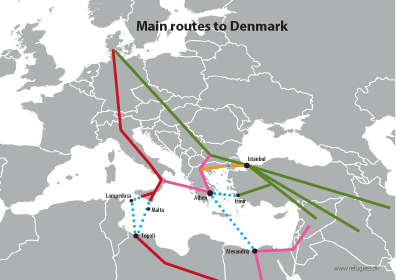The journey to Denmark – routes, risk and cost
Most asylum seekers travel to Denmark on their own and ask for asylum. They are called spontaneous asylum seekers as opposed to quota refugees. You can read more about different refugee statuses, and about How many are coming, and from where at the moment.
Most asylum seekers come from countries where the European Union requires people to hold a visa in order to enter the Schengen area. It is very difficult to obtain a visa if you come from a so-called ‘asylum-producing’ country – even if you have family here. Furthermore, many asylum seekers do not even have a passport and cannot legally leave their country. Since 2002, a person has not been allowed to seek asylum via a Danish embassy. In the 1980s, Denmark was one of the first countries to impose a large fine on airline companies if persons onboard an aircraft arriving in Denmark did not have a valid passport or visa. Later this was also expanded to train- and ferry companies. In this way, private transport companies now carry out border control on behalf of EU states.
Expensive and dangerous
In practice, the only access to Denmark is often ‘illegal’ entry – either with fake documents or no documents. Nearly always, such entry requires assistance from human smugglers who charge a hefty price. For example, the journey from Eritrea to Denmark with help from human smugglers typically costs 45.000 DKr and the journey from Syria to Denmark can cost up to 100.000 DKr. Read more about human smugglers here.
Human smugglers operate in groups and carry people a certain portion of the total journey. Then, migrants will often have to find a new smuggler who can assist with the next part of the journey. Migrants are viewed by smugglers as goods and are often treated inhumanely as a result. Often, families are separated during the journey. Many migrants lose their savings and personal documents and possessions and are exposed to violence and rape along the way. A large number of migrants die during their journeys – the most known death is the many drowning accidents in the Mediterranean Sea, but an unknown number of migrants have died in Sahara and the Sinai desert, and in remote mountainous regions, containers, trucks, and warehouses due to hunger, thirst, and disease.
Currently, the main routes to Europe are either the Mediterranean Sea – through Morocco to Spain, through Libya and Egypt to Italy, through Turkey to Greece – or overland from through Turkey to Bulgaria. Additionally, a smaller number of migrants arrive from Russia, Armenia and China through Eastern Europe. During the sping of 2016 the so-called Balkan route was gradually closed down, and the controversial deal between EU and Turkey about returning refugees from Greece put an efficient stop to refugees from Syria. The deal has caused thousands of refugees to be stranded in Greece from where they can't leave, staying under terrible conditions in camps like the infamous Moria on Lesbos.
The number of people who drowned in the Mediterranean Sea was at least 5,000 in 2016. But this must be seen in relation to the 363,348 who survived and made it – since then, the number of deaths have fallen, but the risk of drowning is significantly higher. This is due to the criminalisation of voluntary rescue work, and the way EU and Italian rescue work has been closed down and replaced with monetary support and collaboration with the Libyan coast guard. A policy which is a clear violation of human rights by sending vulnerable people back to some of the most terrifying deportaion camps in the world.
The solution to this unacceptable situation is not the unrealistic idea from the Danish Social Democrats of a reception center in North Africa. Read more in the catalogue "'Alternativer til flugt og fordrivelse." (in Danish, short summary in English).
The right to ask for asylum
It is a paradox that we have a human right to seek asylum, which most European states respect, but one cannot claim this right without breaking the law and exposing oneself to further danger. Often the few migrants who arrive with a valid passport and visa and thereafter seek asylum will have a hard time obtaining asylum because they have left their country of origin legally. Often, the visa to Denmark is perceived as a misuse and can also trigger a quarantine to the person who invited the migrant to Denmark.
Many of the migrants seeking asylum in Denmark have been en route for more than one year before they arrived in Denmark. It is quite common to be stranded for months in places along the journey, such as Tripoli, Istanbul, or Athens. And before that, many have tried to survive in a neighbour country, some for years. Most of those seeking asylum in Denmark did not have Denmark as their goal of final destination but have been stopped by Danish authorities in the airport or on the train as they were trying to reach other countries like Sweden, Norway or the UK. Because of the Dublin Regulation, they must have their case processed in Denmark.


